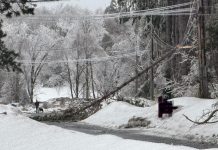Use extreme caution before heading out on a frozen lake or river in Ontario. Temperature changes or a fresh snowfall can contribute to concealing thin ice.
Because so often it may be up to your own discretion when trying to determine ice safety, follow these important tips first. You may think that the first thing you need to do is measure the thickness of the ice, but there are actually two key steps before that.
3 steps for ice safety
There are three unique steps required to assess ice safety:
- Complete a visual inspection
- Note the colour of the ice
- Measure the thickness of the ice
It’s important to follow these three steps (explained in more detail below) before setting up your fishing rod, tying up your skates or starting the engine of your snowmobile. Do not trust that the ice is safe. This is important all the time, but even more so in the early parts of winter and the late spring.
Factors to consider for ice safety
Before selecting a body of water, remember ice safety depends on many things, including:
- size of the body of water
- movement of the water, including currents and tides
- current temperatures / recent and upcoming temperature fluctuations
- fluctuations in water levels
- chemical composition of the water
- depth of the water under the ice
3 steps in detail
You’ve picked your lake and have arrived on site. You must now complete your visual inspection.
1. Visual inspection
During your visual inspection, always remember that logs and rocks absorb the heat from the sun, which results in faster melting and slower formation of ice.
If you see any of these signs during your visual inspection, do not go out onto the ice:
- cracks, breaks or holes in the ice
- water on top of the ice
- water flowing onto the ice
- ice that’s soft or mushy
- flowing springs in spring-fed ponds and lakes
- ice that appears to have thawed and refrozen
- snow on the ice; snow can warm up the ice as it acts like an insulator
2. Ice colour
The next step in the inspection is to look at the colour of the ice, which is extremely important. There are three colours of ice and each means different things when it comes to the ice’s strength:
- Dull grey is a sure sign of unsafe ice. This grey colour means the ice is unsafe and that water is present. This ice will NOT support much weight. Grey is very common in the spring and in faster moving water all winter long.
- White opaque ice or snow ice is only half as strong as blue ice. It is formed by wet snow freezing on the top of existing ice. It can be very dangerous if this ice has formed on top of ice that is not completely frozen. When this forms, it takes even longer for the lower-level ice to solidify. This type of ice can cover up danger and has caught even seasoned anglers off guard.
- Blue ice is clear and strong and the safest ice of all. The colour of ice deepens with increasing thickness because water is naturally turquoise blue. It forms when the temperature drops below minus 8 degrees Celsius.
3. Ice measurement
The final step is ice measurement, and this must always be done. Do not test alone; always ensure you’re using the buddy system. You can chip the ice with an axe or hatchet to create a small hole in the ice or use an ice auger or spud bar. Then measure the thickness of the ice. Continue to check the ice thickness as you move around the lake. Remember: ice thickness is NOT uniform across most lakes and rivers.
When you’re considering heading out for a day of skating, a greater ice thickness is required for a group than for one skater. The Canadian Red Cross recommends that ice should be at least 15 cm (6 inches) thick to carry a single person, but if you’re heading out with a group of friends for skating or a game of shinny, ensure it’s 20 centimetres (8 inches).
Ice thickness for a sled or snowmobile is a minimum of 25 centimetres (10 inches). Always keep in mind when you move around the ice that thickness does vary, so check the depth of the ice often.
For driving on the ice, you’re looking for a minimum of 30 centimetres (12 inches) or more for a light vehicle, according to the Ontario Ministry of Natural Resources. Again, remember this is 30 centimetres of blue ice, so double that thickness if the ice is white or opaque.
Ice safety quick reference
For a quick reference, check the recommended safe ice thicknesses for most ice related activities according to the Canadian Red Cross.
Before leaving home, you should also check with local authorities and never go out on ice at night. Always ensure you have told someone where you are planning to go and your return time. Wear appropriate clothing and bring proper equipment for safety and comfort.
Licence information
For those heading out to ice fish, remember that Canadian residents between 18 and 65 years of age need an Outdoors Card. In addition, you must get a fishing licence. There are two types of licences—sport and conservation—and you can get a fishing licence for one day, 8 days, one year or three years. You can buy licences online.
For non-residents, if you’re over 18 years of age, remember to get your Outdoors Card. You can purchase a fishing licence for one or three years. If you’re a non-resident under 18 accompanied by a person with a valid Outdoors Card and Fishing Licence, you don’t need either document.
However, “any fish you keep are part of the catch and possession limit of the person holding the licence. To gain your own limits you need your own Outdoors Card and Fishing Licence” (MNR Fishing Regulations).
You must also follow all restrictions for limits, size, catch and release and open and close seasons for fish species. It is your responsibility to know this information.
Download the full Ontario Fishing Regulations Summary.
Be safe and enjoy the best of Ontario during our epic winters!








